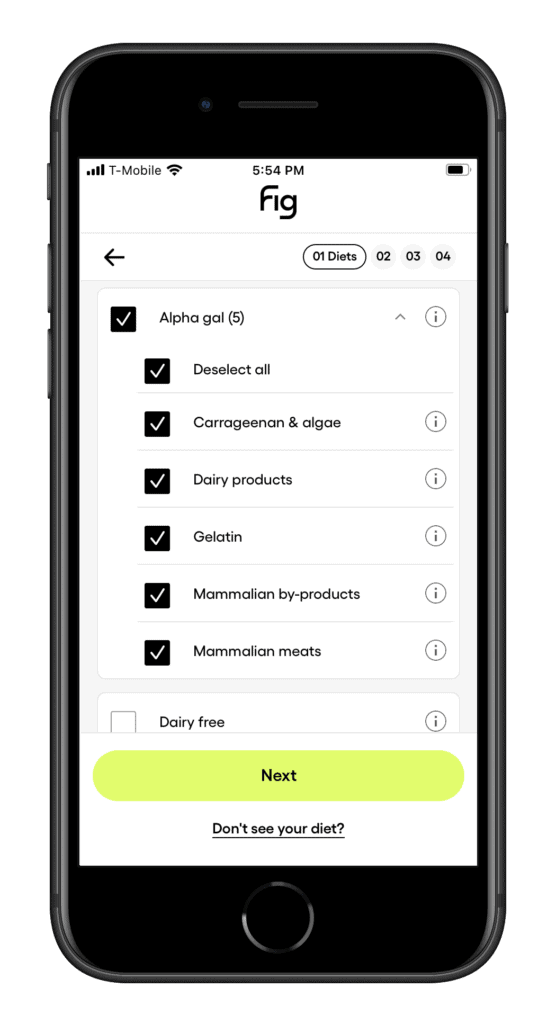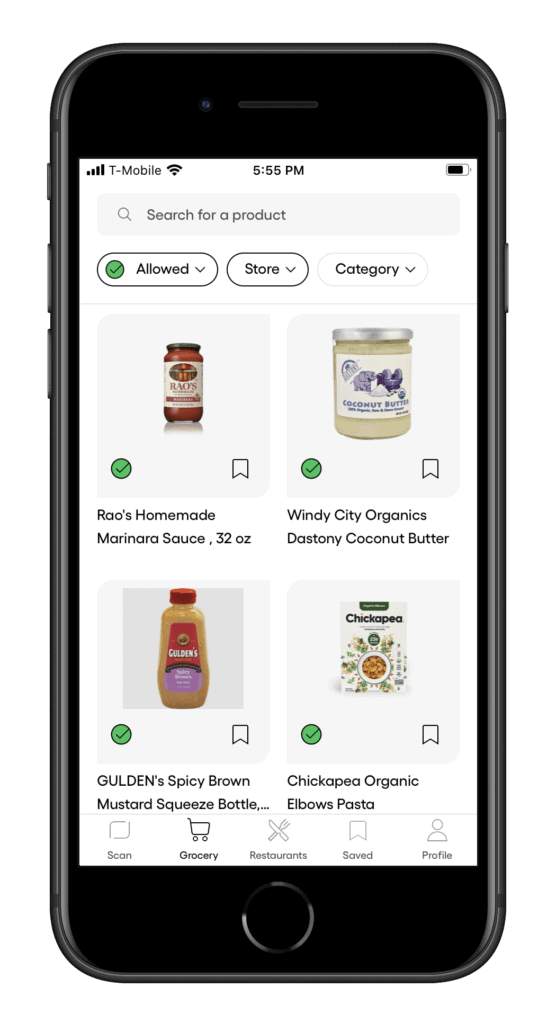


Find foods you can eat.
Alpha-Gal Allergy
Published on November 1, 2022What is an Alpha-Gal allergy?
An Alpha-Gal allergy is an allergy to alpha-gal, a sugar found in mammalian meat. Examples of mammalian meat include beef, pork, lamb and rabbit. Alpha-gal is an abbreviation for a type of sugar called galactose-α-1,3-galactose. An Alpha-Gal allergy is also called Alpha-Gal Syndrome (AGS).
Although once thought to be very rare, prevalence of Alpha Gal allergy appears to be growing, particularly in the southeastern United States. Alpha Gal Syndrome most commonly develops after an individual is bitten by the Lone Star tick. This bite transmits alpha-gal into the person’s body.
For some people, this transmission of alpha-gal triggers an immune reaction that later causes an allergic reaction to alpha-gal-containing foods. Alpha-gal allergies can range from mild to severe. People with alpha-gal allergies should generally avoid consuming any foods containing alpha-gal. This is the best way to prevent a serious allergic reaction called anaphylaxis.
Symptoms of Alpha-Gal
Here is a list of symptoms of an alpha-gal allergic reaction:
- Hives and itchy skin
- Shortness of breath or wheezing
- Sneezing and/or runny nose
- Swelling of the lips, mouth, tongue, throat, or other body parts
- Headache
- Gastrointestinal symptoms such as abdominal pain, diarrhea, nausea, or vomiting
- Rapid pulse
- Dizziness or lightheadedness
- Tightness in the throat
Alpha-gal allergic reactions generally occur 3-6 hours after exposure to alpha-gal. This is different from other types of allergic reactions which typically occur a few minutes to 2 hours after eating the offending agent.
Your doctor may recommend that you carry an EpiPen in case you accidentally consume alpha-gal. You should immediately seek medical care if you experience severe allergy symptoms and need to use your EpiPen.
Alpha-Gal Test
A physician can diagnose you with Alpha-Gal Syndrome by asking about your medical history, current symptoms and potential exposure to tickets. They may also order a blood test to measure alpha-gal antibodies in your blood or conduct a skin prick test.
At Quest Diagnostics, the blood test for Alpha Gal is the Quest Alpha-gal IgE Test Code 95241. At LabCorp, the blood test is the Labcorp Alpha-gal IgE Test Code 806562.
For a skin prick test, the doctor will prick your forearm or back with a needle. This will expose your body to liquid that contains alpha-gal. If you are allergic, a raised bump will develop underneath the skin at the test site.
Alpha-gal foods to avoid
An alpha gal diet is one that excludes dietary sources of alpha-gal, so red meat is off the table. Byproducts from mammals may also contain smaller quantities of alpha-gal. These byproducts include gelatin, milk, fats derived from mammals, meat broths, and gravies. There’s no need to avoid non-mammalian animal proteins like poultry, seafood, and eggs. The easiest way to find foods that likely work for an Alpha Gal diet is on the Fig app.
Foods to avoid with alpha-gal
- Beef, pork, lamb, mutton, goat, rabbit, bison, venison, and other mammalian meats including organ meats
- Foods made with mammalian meat byproducts or extracts such as gelatin, gravy, lard, tallow, suet, broths, bouillon, and stock made with mammalian meat
- Less obvious ingredients to avoid on an alpha gal diet:
- Gelatin including alcohol that is clarified or filtered with gelatin
- Collagen
- Casein
- Whey
- Lactose
- Glycerin
- Stearic acid
- Oleic acid
- Arachidyl propionate
- Arachidic acid
- Alpha-lactalbumin
- Butyric acid
- Caprylic acid
- Caproic acid
- Lanolin
- Magnesium stearate
- Carrageenan and other red-algae ingredients
- Sausage casings derived from the gut of a mammal (sometimes used for chicken and turkey sausage)
- Flounder roe (eggs of flounder fish)
For a full list of ingredients you need to avoid on an alpha gal diet, download the Fig app and set it to an Alpha Gal profile. You’ll be able to see and search a list of thousands of ingredients. Fig will also show you thousands of products that work for an alpha gal diet at each grocery store.
Alpha Gal and Dairy
Some individuals with AGS may also react to dairy products such as cow’s milk, goat’s milk and sheep’s milk. These reactions may also occur with cheeses, yogurts, ice creams, and other dairy-containing foods. If you still experience allergic symptoms after eliminating all red meat and extracts, you may need to do a full avoidance of dairy products. You can also use the Fig app to avoid dairy ingredients.

Foods to eat on an alpha-gal diet may include:
- Fruits and vegetables
- Breads, pastas, rice, and other grains
- Beans and legumes
- Nuts and seeds
- Eggs
- Fish
- Shellfish (such as shrimp, prawns, crab, and lobster)
- Mollusks (such as clams, oysters, mussels, squid, octopus, and snails)
- Poultry (such as chicken, turkey, and duck)
Helpful Tips When Starting an Alpha Gal Free Diet
When following an alpha-gal diet, it is important to keep in mind that less obvious sources of alpha-gal may be hiding in certain processed foods. This makes them unsafe for those with AGS to consume. The Fig app has a barcode scanner and is a great way to spot these hidden ingredients.
When eating out at restaurants, it’s important to clearly communicate your dietary restrictions to your server. Explain that you cannot eat red meat, dairy, or foods derived from red meat like animal fats and gelatin. Those with severe AGS should also ask about cross-contamination. This is to reduce the risk of food coming into contact with mammalian meat or byproducts. Unlike many protein allergens that are denatured by heat, alpha-gal is heat stable under normal cooking temperatures.
When attending social gatherings, take extra precaution and inquire about the ingredients in foods. Additionally, ask how the food was prepared. If you are unsure if a food is safe for you to consume, it is best to avoid risking a severe allergic reaction. Consider bringing a “safe” food or dish that you know you can eat. Alternatively, have a snack or meal before you go.
Getting the right nutrition on an alpha-gal diet
It should be easy to meet your nutritional needs while following an alpha-gal diet. However, there are a few nutritional considerations to keep in mind:
Protein on Alpha-Gal Diet
We need protein for various metabolic processes and to build and repair our body’s tissues. Since red meat and dairy are rich and highly bioavailable sources of protein, it’s important to make sure you’re eating other protein-rich foods. This is particularly important if you have other dietary restrictions. Poultry, seafood, eggs, tofu, tempeh, seitan, beans, legumes, nuts, seeds, soy milk, and quinoa are just a few of the many alpha-gal friendly protein sources to choose from.
Iron on Alpha-Gal Diet
Iron serves a number of important functions in our bodies. It is best known for its crucial role in blood production. Iron is a part of hemoglobin, a protein that carries oxygen in our blood. Without sufficient iron, oxygen delivery to body tissues is impaired and we may feel fatigued and short of breath.
Red meat is high in bioavailable iron, so if you are used to consuming it regularly, you’ll want to make a conscious effort to include other iron sources. Other foods high in iron include seafood, beans and legumes such as lentils and chickpeas, nuts and seeds, dried fruit such as dried figs and apricots, and iron-fortified cereals. Pairing plant-based iron sources with vitamin C sources like lemon juice, tomato sauce, or fresh fruits and vegetables helps to boost iron absorption.
Calcium on Alpha-Gal Diet
We need calcium to build and maintain strong bones. Calcium is also important for proper nervous system function and regulation of our cardiovascular function. Dairy products are rich in calcium, so if you must avoid them, you’ll want to include alternative sources.
Other foods high in calcium include calcium-fortified milk alternatives, dark leafy green vegetables (especially those in the cruciferous family like broccoli, bok choy, and kale), nuts and seeds, and tofu made with calcium sulfate. For more on how to incorporate calcium on a dairy-free diet, check out our blog post here!
Vitamin B12 on Alpha-Gal Diet
Vitamin B12 is found predominantly in animal products and is needed to support metabolism and the production of DNA and red blood cells. This vitamin also supports proper brain and nervous system function.
If you avoid alpha-gal and other animal products like poultry, seafood, and eggs, it’s important to include plant-based sources of B12. These include nutritional yeast and B12-fortified milk alternatives and cereals. You may also consider taking a B12 supplement to ensure you’re meeting your needs.
Who is an Alpha-Gal Diet Not For?
People with Alpha-Gal allergy should follow an alpha-gal free diet.
If you do not have AGS, following an alpha-gal-free diet is unnecessary; however, it is not harmful. In fact, removing red meat from your diet or limiting your red meat consumption may reduce your risk for cardiovascular disease and various cancers.
Alpha Gal app: Find foods you can eat with Fig

Build your Alpha-gal friendly shopping list with the Fig app!
Check if products are alpha gal friendly online.
Photo by Hermes Rivera on Unsplash
 Low FODMAP Breakfast
Low FODMAP Breakfast Introduction to Lactose Free Diets
Introduction to Lactose Free Diets